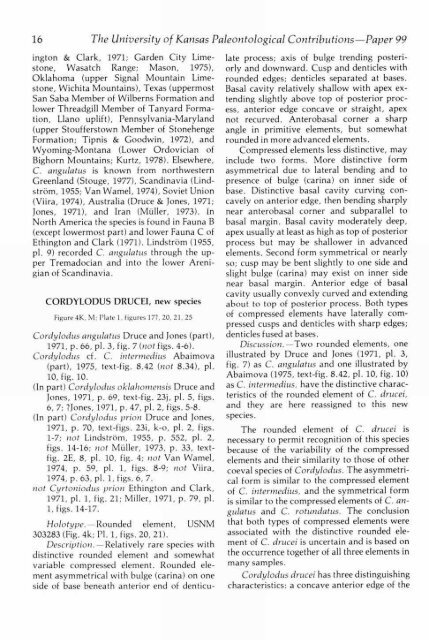View - KU ScholarWorks - University of Kansas
View - KU ScholarWorks - University of Kansas
View - KU ScholarWorks - University of Kansas
Create successful ePaper yourself
Turn your PDF publications into a flip-book with our unique Google optimized e-Paper software.
16 The <strong>University</strong> <strong>of</strong> <strong>Kansas</strong> Paleontological Contributions-Paper 99<br />
ington & Clark, 1971; Garden City Limestone,<br />
Wasatch Range; Mason, 1975),<br />
Oklahoma (upper Signal Mountain Limestone,<br />
Wichita Mountains), Texas (uppermost<br />
San Saba Member <strong>of</strong> Wilberns Formation and<br />
lower Threadgill Member <strong>of</strong> Tanyard Formation,<br />
Llano uplift), Pennsylvania-Maryland<br />
(upper Stoufferstown Member <strong>of</strong> Stonehenge<br />
Formation; Tipnis & Goodwin, 1972), and<br />
Wyoming-Montana (Lower Ordovician <strong>of</strong><br />
Bighorn Mountains; Kurtz, 1978). Elsewhere,<br />
C. angulatus is known from northwestern<br />
Greenland (Stouge, 1977), Scandinavia (Lindstrom,<br />
1955; Van Wamel, 1974), Soviet Union<br />
(Viira, 1974), Australia (Druce & Jones, 1971;<br />
Jones, 1971), and Iran (Müller, 1973). In<br />
North America the species is found in Fauna B<br />
(except lowermost part) and lower Fauna C <strong>of</strong><br />
Ethington and Clark (1971). LindstrOm (1955,<br />
pl. 9) recorded C. angulatus through the upper<br />
Tremadocian and into the lower Arenigian<br />
<strong>of</strong> Scandinavia.<br />
CORDYLODUS DRUCEI, new species<br />
Figure 4K, M; Plate 1, figures 177, 20, 21, 25<br />
Cordylodus angulatus Druce and Jones (part),<br />
1971, p. 66, pl. 3, fig. 7 (not figs. 4-6).<br />
Cordylodus cf. C. intermedius Abaimova<br />
(part), 1975, text-fig. 8.42 (not 8.34), pl.<br />
10, fig. 10.<br />
(In part) Cordylodus oklahotnensis Druce and<br />
Jones, 1971, p. 69, text-fig. 23j, pl. 5, figs.<br />
6, 7; ?Jones, 1971, p. 47, pl. 2, figs. 5-8.<br />
(In part) Cordylodus prion Druce and Jones,<br />
1971, p. 70, text-figs. 23i, k-o, pl. 2, figs.<br />
1 -7; not LindstrOm, 1955, p. 552, pl. 2,<br />
figs. 14-16; not Müller, 1973, p. 33, textfig.<br />
2E, 8, pl. 10, fig. 4; not Van Wamel,<br />
1974, p. 59, pl. 1, figs. 8-9; not Viira,<br />
1974, p. 63, pl. 1, figs. 6, 7.<br />
not Cyrtoniodus prion Ethington and Clark,<br />
1971, pl. 1, fig. 21; Miller, 1971, p. 79, pl.<br />
1, figs. 14-17.<br />
Holotype. -Rounded element, USNM<br />
303283 (Fig. 4k; Pl. 1, figs. 20, 21).<br />
Description. -Relatively rare species with<br />
distinctive rounded element and somewhat<br />
variable compressed element. Rounded element<br />
asymmetrical with bulge (caria) on one<br />
side <strong>of</strong> base beneath anterior end <strong>of</strong> denticulate<br />
process; axis <strong>of</strong> bulge trending posteriorly<br />
and downward. Cusp and denticles with<br />
rounded edges; denticles separated at bases.<br />
Basal cavity relatively shallow with apex extending<br />
slightly above top <strong>of</strong> posterior process,<br />
anterior edge concave or straight, apex<br />
not recurved. Anterobasal corner a sharp<br />
angle in primitive elements, but somewhat<br />
rounded in more advanced elements.<br />
Compressed elements less distinctive, may<br />
include two forms. More distinctive form<br />
asymmetrical due to lateral bending and to<br />
presence <strong>of</strong> bulge (caria) on inner side <strong>of</strong><br />
base. Distinctive basal cavity curving concavely<br />
on anterior edge, then bending sharply<br />
near anterobasal corner and subparallel to<br />
basal margin. Basal cavity moderately deep,<br />
apex usually at least as high as top <strong>of</strong> posterior<br />
process but may be shallower in advanced<br />
elements. Second form symmetrical or nearly<br />
so; cusp may be bent slightly to one side and<br />
slight bulge (caria) may exist on inner side<br />
near basal margin. Anterior edge <strong>of</strong> basal<br />
cavity usually convexly curved and extending<br />
about to top <strong>of</strong> posterior process. Both types<br />
<strong>of</strong> compressed elements have laterally compressed<br />
cusps and denticles with sharp edges;<br />
denticles fused at bases.<br />
Discussion. -Two rounded elements, one<br />
illustrated by Druce and Jones (1971, pl. 3,<br />
fig. 7) as C. angulatus and one illustrated by<br />
Abaimova (1975, text-fig. 8.42, pl. 10, fig. 10)<br />
as C. intermedius, have the distinctive characteristics<br />
<strong>of</strong> the rounded element <strong>of</strong> C. drucei,<br />
and they are here reassigned to this new<br />
species.<br />
The rounded element <strong>of</strong> C. drucei is<br />
necessary to permit recognition <strong>of</strong> this species<br />
because <strong>of</strong> the variability <strong>of</strong> the compressed<br />
elements and their similarity to those <strong>of</strong> other<br />
coeval species <strong>of</strong> Cordylodus. The asymmetrical<br />
form is similar to the compressed element<br />
<strong>of</strong> C. intermedius, and the symmetrical form<br />
is similar to the compressed elements <strong>of</strong> C. angulatus<br />
and C. rotundatus. The conclusion<br />
that both types <strong>of</strong> compressed elements were<br />
associated with the distinctive rounded element<br />
<strong>of</strong> C. drucei is uncertain and is based on<br />
the occurrence together <strong>of</strong> all three elements in<br />
many samples.<br />
Cordylodus drucei has three distinguishing<br />
characteristics: a concave anterior edge <strong>of</strong> the
















